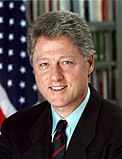| |||||||||||||||||||||||||||||||||
All 18 Michigan votes to the Electoral College | |||||||||||||||||||||||||||||||||
|---|---|---|---|---|---|---|---|---|---|---|---|---|---|---|---|---|---|---|---|---|---|---|---|---|---|---|---|---|---|---|---|---|---|
| Turnout | 54.5% | ||||||||||||||||||||||||||||||||
| |||||||||||||||||||||||||||||||||
| |||||||||||||||||||||||||||||||||
| |||||||||||||||||||||||||||||||||
| Elections in Michigan |
|---|
 |
The 1996 United States presidential election in Michigan took place on November 5, 1996. All 50 states and the District of Columbia participated in the 1996 United States presidential election. Voters chose 18 electors to the Electoral College, which selected the president and vice president.
Michigan was won by incumbent United States president Bill Clinton of Arkansas, who was running against Kansas senator Bob Dole. Clinton ran a second time with former Tennessee senator Al Gore as Vice President, and Dole ran with former New York congressman Jack Kemp.[2]
Michigan weighed in for this election as 5% more Democratic than the national average. The presidential election of 1996 was a very multi-partisan election for Michigan, with nearly 10% of the electorate voting for third-party candidates. In typical form for the state, the Upper Peninsula of Michigan voted mainly Democratic, and the Lower Peninsula was divided, but more Republican—with the notable exception of Detroit's highly populated Wayne County, which voted overwhelmingly Democratic. In his second bid for the presidency, Ross Perot led the newly reformed Reform Party to gain over 8% of the votes in Michigan, and to pull in support nationally as the most popular third-party candidate to run for the United States presidency in recent times. This marked the first time since 1968 that the state voted Democratic in consecutive elections.
As of the 2020 presidential election[update], this is the last election in which Houghton, Alcona, Cheboygan, Crawford, Dickinson, Kalkaska, Luce, Mackinac, Mecosta, Lapeer, Keweenaw, Montcalm, Tuscola, Branch, Baraga, Chippewa, Huron, Wexford, Osceola, Montmorency, and Oscoda Counties voted for a Democratic presidential candidate. This is also the last time all counties in the Upper Peninsula voted for a Democrat.[3]
The year 1996 marked a turning point for Michigan, as it would become the most Democratic-leaning of the three Rust Belt swing states (also consisting of Wisconsin and Pennsylvania), a status it held until 2024. Even though Michigan would vote for Donald Trump in the 2016 U.S. presidential election alongside Wisconsin and Pennsylvania, it was still the most Democratic-leaning of the three states. Michigan was also the most Democratic of the three in 2020.
- ^ "SOS - General Election Voter Registration/Turnout Statistics".
- ^ "1996 Presidential General Election Results – Michigan". Dave Leip's Atlas of U.S. Presidential Elections. Retrieved July 21, 2013.
- ^ Sullivan, Robert David; ‘How the Red and Blue Map Evolved Over the Past Century’; America Magazine in The National Catholic Review; June 29, 2016





